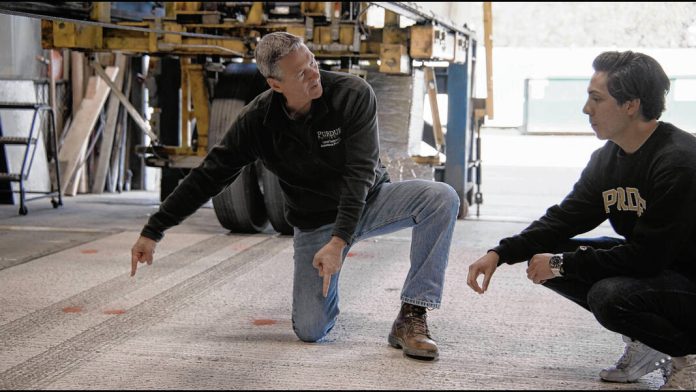
Photo provided by Consensus Digital Media Purdue Professor John Haddock and graduate student Oscar Moncada examine a slab of concrete pavement they tested to handle heavy truckloads with wireless power-transfer technology installed below the surface. The machine behind them is designed to imitate those loads by repeatedly passing half a loaded semi-truck axle across the concrete slab.
The Indiana Department of Transportation is partnering with Cummins Inc. and Purdue University to install and test what has been billed as the first stretch of highway in the United States that can wirelessly charge electric vehicles as they drive down the road.
The project, which has an estimated $11 million price tag, seeks to install the new technology underneath a quarter-mile stretch of U.S. Highway 231/U.S. Highway 52 in West Lafayette, INDOT said. State officials said they expect to start removing pavement from the test site to install the Purdue-designed technology as early as Monday, with construction expected to continue through the fall and some additional work to last until May 2025.
Essentially, construction crews will install electromagnetic coils underneath the pavement that will allow electric vehicles with a receiver to charge up their batteries while driving over the test site. The technology is similar to how some smartphones use magnetic fields to wirelessly charge when placed on a charging pad.
While similar projects have been done in other states and countries, the Indiana project has been billed as the first aimed at charging both heavy-duty and passenger electric vehicles while traveling at highway speeds, which requires higher power levels, according to Purdue.
Officials said they hope the project will contribute to the development of electrified highways that could help curb greenhouse gas emissions in the transportation sector, which accounted for 29% of total U.S. greenhouse gas emissions in 2021, according to the U.S. Environmental Protection Agency.
If electric trucks could charge using highways, their limited range could be extended and their batteries could be reduced in size, allowing them to carry more freight, significantly reducing costs of using electric vehicles to haul freight, officials said.
INDOT said it hopes to electrify a section of an Indiana interstate for further testing within four to five years.
Cummins, which is headquartered in Columbus and is the largest employer in the area, plans to test Purdue’s wireless charging technology with a Kenworth T680 truck that has been modified to be fully battery electric, said company spokeswoman Lauren Daniel.
The vehicle will be one of two trucks that Cummins previously developed for a project funded by the U.S Department of Energy that uses high-power stationary wireless charging to demonstrate 20 hours a day operation, Daniel said. The DOE project is expected to be completed by the end of this year.
The fully electric truck will drive over the test site as part of a pilot program that is tentatively planned to start next year, INDOT said.
“At the conclusion of the DOE project … the charging system on one of the trucks will be converted from its existing stationary wireless charging system to the Purdue dynamic wireless power transfer system,” Daniel said.
The Indiana project adds to a growing list of similar projects that seek to test the effectiveness of charging electric vehicles while in motion.
Last year, a quarter-mile stretch of 14th Street just west of downtown Detroit was equipped with similar technology, The Associated Press reported.
The technology in the Detroit project belongs to Electreon, an Israel-based developer of wireless charging solutions for electric vehicles, according to wire reports. The company has contracts for similar roadways in Israel, Sweden, Italy and Germany.
INDOT, for its part, said the technology is has undergone multiple levels of research and testing and has been found to be safe for motorists. The magnetic fields cannot electrocute drivers.
Purdue researchers plan to focus first on testing how well the technology transfers power to electric trucks, INDOT said.




